Anyone wanting to grow saffron should not leave their garden in October. Of course, that is exactly what I did to catch up with the family in the U.K. but I was lucky and I don’t think I had lost too many of the flowers when I returned a couple of days ago.
I was very pleased to see that almost all the bulbs that I had planted last year had come up and some will need to be lifted and split again this year. This year we have had a lot of rain and we had been told by a saffron producer in the area that some of her bulbs had rotted in the ground, so I was concerned that I might have lost mine too.
I find saffron my most pleasant crop to harvest. The flowers are not produced over a long period and picking the flowers on my small scale is not tiresome. All that remains for me to do is fold back the petals and remove the three bright orange stigma and place them on a plate to dry.
I would like to grow an annual plant over my saffron during spring and summer, especially one that might enrich the ground and save me constantly weeding.
Any ideas?
I was a bit late last night collecting the flowers and this bumble bee had already settled down for the evening. I’m afraid I turfed her out but she was so sleepy she did not mind me swapping her saffron crocus for another just as comfortable flower.
My self-sown tomato plant is still happy and producing tomatoes beside the ferns in the well. It seems not only happy to produce tomatoes in this strange place but to continue producing them into late October.
With temperatures between 26 and 28 degrees Centigrade these past few days it is hard to believe we are in October. The Cosmos is looking tired but I cannot lift it yet as it is still flowering and is being visited by the Carpenter and other bees.
The Dahlias are still going strong and are a magnet for all the bees – this one is a male Halictus bee. My sister brought me some seeds of the dahlia “Yankey Doodle Dandy” and although I planted them in early June I now have several flowering plants like the one above. I’m not sure if it was the flower shape or the name that spurred her to purchase the seeds.
One of the Philadelphus has pushed out a flower on one side whereas it looks as if it is going into its autumn shut down on the other side.
The Tradescantia has popped up again.
And the some of the Hollyhocks are on their second flowering. The bees are still busy but some of the bumbles, like the one above are getting tired and their colours are fading.
The cool weather must arrive soon but until then I can enjoy another “last day at the beach for this year”.

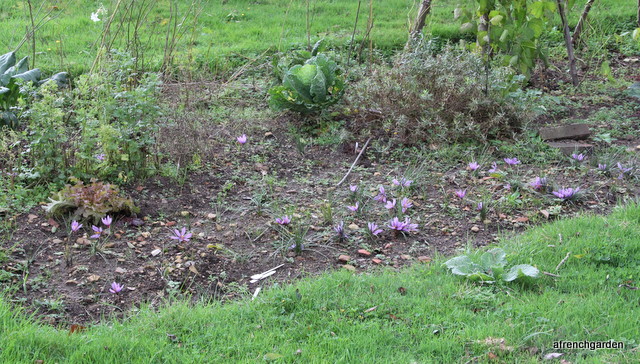
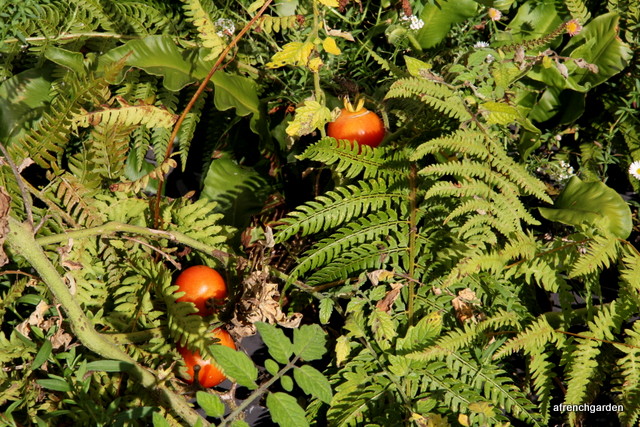
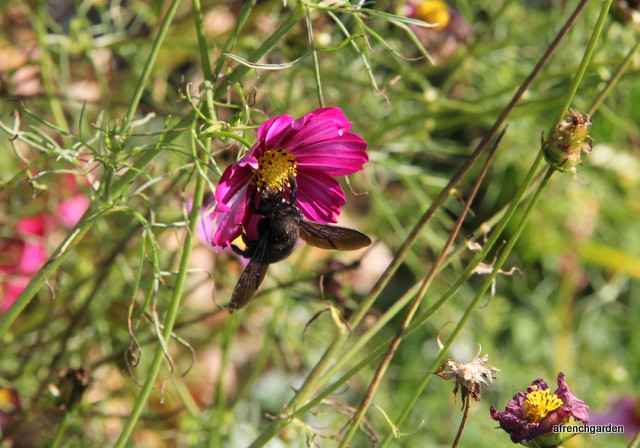

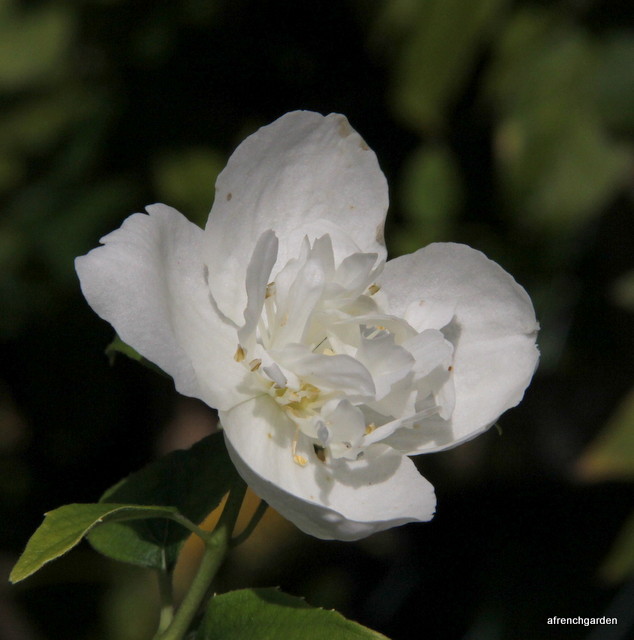
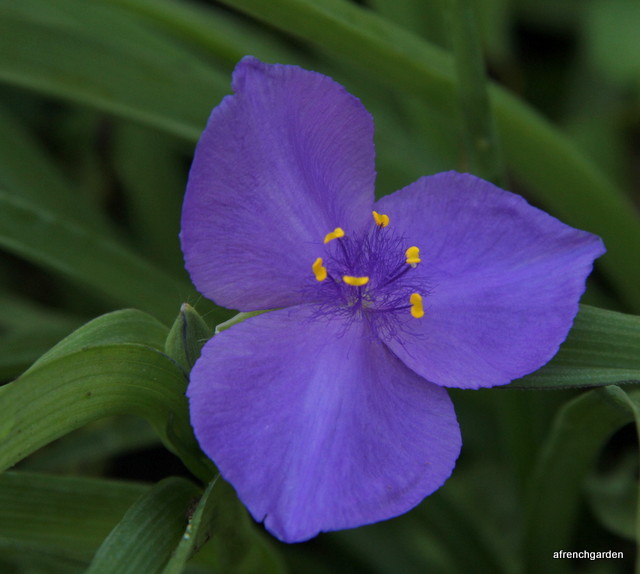

Saffron, eh? . . . I imagine it beats blowing a small fortune at the store for it.
LikeLike
Yes, didn’t realise it could be grown in Europe. I wonder how far north it will go…
LikeLike
It can grow it in the U.K. at least. That is where the name Saffon Walden came from as it used to be grown there. Amelia
LikeLike
Oh yes, I see 🙂
LikeLike
I haven’t calculated exactly but it might be my best cash crop. It is certainly a lot more fun than cleaning broad beans or sprouts. Amelia
LikeLike
What do you do with your fresh saffron?
LikeLike
Dry it. There are various ways to use it in cooking but I grind it so it is best to be dry for grinding and also for storing. I use it in various rice dishes. Its flavour is very delicate so I do not associate it with strong flavours. Amelia
LikeLike
Nice one, Amelia…
not a huge amount when dried…
but absolutely fresh and not x-years old…
and, if you are entertaining…
ALL your own produce!!
Lovely…
For an annual, that will have died back by now and you’ll have ripped it up for the compost heap…
try Poached Egg Plant…
excellent ground cover, self-seeds and a very good bee and hoverfly plant…
and the leaves are of course NOT grass like….
LikeLike
That is an excellent idea. I tried it once and I found that it started to cover too many things but that is exactly what I need here. Do you know any leguminous annuals – just thinking about improving the soil too? Amelia
LikeLike
You chose the right time to return the warm weather we enjoyed here is changing to rain, wind and cooler. Growing Saffron crocuses sounds exciting, what do you use the Saffron for? Phacelia tanacetifolia may be worth considering as a plant for the spring and summer.
LikeLike
I use the saffron for flavouring rice dishes, it has a very delicate flavour and smells lovely. I have tried Phacelia once but was not successful but I think that must have been me or bad luck and I would like to try it again as a bee trap! Amelia
LikeLiked by 1 person
I think I’d grow an herb with the saffron. Just about any one that doesn’t form a thick mat would do.
You’re lucky to see a second bloom on so many of your plants.
LikeLike
A lot of the herbs go on for a long time here like thyme and parsley but I’ll think about it. This has been such a special year with almost no winter to start it. I am going to find it tough when the cold weather finally hits us. Amelia
LikeLike
It has been a mild autumn here, and very wet the last week or so. Most of the flowers have given up after being drenched in a downpour, but the odd bee or butterfly are still there as soon as it dries up again! I wonder what you will use your saffron for? I find the flowers so pretty for autumn.
LikeLike
I use it to flavour rice dishes. In addition, if I want plain rice to look really pretty once I have served it on the table I mix a tablespoon of cooked rice with some saffron and garnish the rice with it. Amelia
LikeLike
A timely post as we spotted some Meadow Saffron in a rough meadow last week. Very pretty.
LikeLike
I’ve never seen wild saffron! That was such a find. Amelia
LikeLike
How funny, we both posted about our Crocus sativa today! I’ve been reading some of the suggestions for companion plants with interest, mine are just mulched and they’re under the Rosa mutabilis. I also photographed the same colour Cosmos with a Carpenter bee!
LikeLike
Great minds! If I had good mulch I think that would work well. I buy wood chips for my strawberries and that works very well. However, I have read that wood chips leach the nitrogen from the soil as they decompose. My strawberries don’t seem to have suffered so far but I am not a great strawberry connoisseur. By the way, my Rosa mutabilis that I first “saw” in your garden has been a delight this year and is still flowering. Amelia
LikeLike
Lovely to have the extra warmth. When you say ‘lift’ the cosmos, does that mean you lift it out and compost it?
LikeLike
Yes, it would be interesting to know if you do that or save it for next year.
LikeLike
I pull the cosmos out and compost it. It does not come up again apart from self seeding. I have just bought some dwarf seeds that were recommended by NHG, I never knew you could get shorter ones – not very short but every little helps. Amelia
LikeLiked by 1 person
In your garden, ‘short’ may turn out as normal size. 😉
LikeLiked by 1 person
Another possibly plant which covers the ground and which bees love is phacelia. It has fern-like leaves and purple flowers. The bees are still enjoying some in my garden, which is great to see 🙂
LikeLike
I will try that again but I have not been successful with that here because it is so good to attract the bees and improve the soil. Amelia
LikeLike
I don’t know enough about it to understand why it didn’t work for you. Perhaps the birds ate all the seed…..
LikeLike
Crocus sativus (your saffron crocuses) will grow further north if the conditions are right and in the 16th century saffron was grown on the eastern side of the UK. The Essex town of Saffron Walden changed its name in honour of the crop.
Meadow Saffron (colchicum autumnale) is a different species. I remember seeing it growing wild in France many years ago but it is to be respected as every part of the plant is highly poisonous.
LikeLike
That has got my crocuses sorted out. I have admired the large garden autumn crocus but I did not realise they were poisonous. I think the only trouble about growing saffron in the UK might be leaving them in ground that did not drain well otherwise you could lift them and store them until the next season. Amelia
LikeLike
Hello Amelia,
Well done with the Saffron. I had an idea for an annual and scrolled thro’ the comments to see its been mentioned already…i.e. Limnanthes ( Poached Egg). But I was going to suggest the white form (douglasii, I think, possibly called ‘Meringue’). We find the white form flowers a bit earlier than the normal yellow/white, but is also really popular with honey and bumble bees. It dies down pretty early, and just now a second generation of seedlings are popping up, which will overwinter. But I wondered how tall the leaves of the Crocus are, since the foliage of Lim. can be quite dense. Alternatively, what about Echium ‘Blue bedder’, which is also great for bees and could be ripped up if still going strong, before the saffron pops up?
Great pics,
BW
Julian
LikeLike
I’ve got Echium going here at the moment, I think I would have to rip it out in say the beginning of September. It may just be that I’ll have to do an experimental strip bed with all these wonderful ideas to see which one suits the soil best. I am very impressed that all the ideas were bee friendly. It would make a great bee spotting area during the spring and summer. I’ve seen the white form of the Limnanthes which might be good for the early solitary bees. Amelia
LikeLike
An experiment with different plants seems a great idea. Look forward to hearing how it works out!
LikeLiked by 1 person
Congratulations on your saffron harvest. I tried growing it once and failed but may take another crack at it if I come across bulbs again. Are you planning to save seeds from that tomato plant? It seems like a good grower so if the flavor’s good it might be worth it.
LikeLike
I’m not sure about your climate for the saffron. They should flower the first year if you plant the bulbs in August but it is whether they come up again or if you have the energy to lift and replant every year.
I must admit I thought about taking the seed, because they taste good, but I find growing tomato plants from seed very difficult. I’ve tried them in a little covered staging but I either grill them because I forget to take them out when it is hot or I freeze them when I forget to put them to bed for the night. I am not always home to look after them, on a daily basis, in the spring either. Amelia
LikeLike
I’d never thought of harvesting saffron from my crocuses. Maybe I need to plant more and try next year.
LikeLike
Remember Saffron crocuses are a special edible species. There are other plants that may resemble them but could be poionous. For instance, saffron crocus are Crocus sativus, whereas the large purple flowers we call autumn crocus in Europe are Colchium autumnale which are poisonous. So make sure you by the correct bulbs 🙂 Amelia
LikeLike
Will do!
LikeLike
A few days have passed since you posted this nice post, the clocks have changed and still the flowers persist. This weekend, quite a few foraging bees were out and about, and even some tortoiseshell butterflies… RH
LikeLike
The weather here continues unseasonally warm – but no complaints. Most of my solitary bees are all gone now but the bumbles are still quite active and the carpenters are around too. Amelia
LikeLike
Pingback: It had to happen… | a french garden